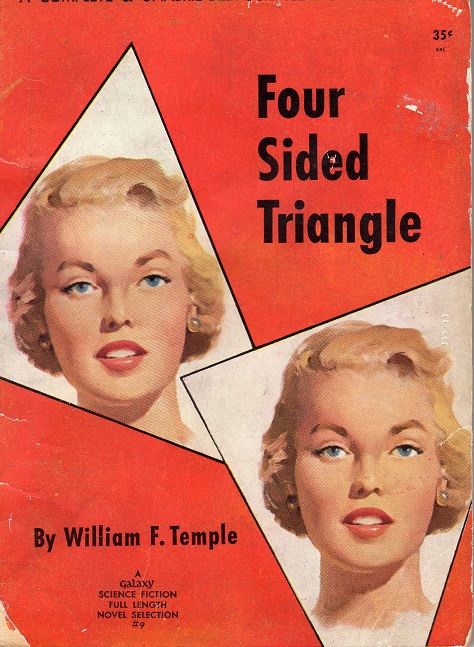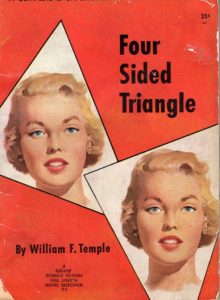Book Review: Four Sided Triangle by William F. Temple
Suppose for a moment that you had access to a device that would create an exact duplicate of any object placed inside. What would you do with it? Solve world hunger? Commit massive art fraud? Resolve your sexual attraction to your best friend’s wife? Yeah, that last one is the possibility we’re exploring here.
This 1949 novel is narrated by Dr. Harvey, one of the last old-fashioned country doctors in the village of Howdean. He’s very specifically not possessed of a full scientific education, and would never pass muster in today’s technically-oriented medical profession (indeed, he’s already having trouble keeping up when he’s in his forties!) But he is bright enough to realize that young Bill Leggett is a child prodigy.
Dr. Harvey acts as a mentor to the young genius as much as he can, and when Bill’s abusive and alcoholic father dies, gets himself appointed Bill’s guardian. He sponsors Bill’s further education, and secures the lad a scholarship to Cambridge. At university, Bill meets and becomes friends with Robin Heath, who as it turns out is the son of the lord of the shire Howdean is located in. Robin is much more conventional in his thinking than Bill, and not nearly as brilliant, but is a good steady problem-solver who complements Bill’s impatience well.
With a loan from Rob’s father, the two young men start a research laboratory (“the Dump”) together on the outskirts of Howdean. While they are pursuing their esoteric goals, Dr. Harvey is called upon to aid a young woman who’s taken a drug overdose. This is Lena, a beautiful (of course) lass with an artistic bent, a fervor for creation, and no noticeable artistic or musical spark. She can play other people’s compositions competently, and is good at art and color theory, but whenever she tries to create something new, the result is a fiasco. Thus her attempt at suicide.
Dr. Harvey realizes that Lena needs a completely new endeavor to distract her from fatalistic thoughts, and convinces Bill and Rob to take her on as a sort of housekeeper and general assistant. This works swimmingly. The young men both take a fancy to Lena, Bill’s soaring imagination and Rob’s common sense working together to restore her love of life, and her bright spirit (and a spot of much-needed cash) allowing the Reproducer to become functional.
Things go well for a while, with the Reproducer bringing the young scientists renown and steady paychecks. Dr. Harvey’s share of the enterprise even allows him to take early retirement from active medical practice. But just as Bill is ready to propose to Lena, Lena proposes to Rob, and the latter two get married.
Bill does not take this well, but he has a plan. He’s been working on a way to allow the Reproducer to duplicate living beings. If there were another Lena, then she could marry him and everything would be hunky-dory! Yeah. The obvious objections are raised, but the somewhat selfless Lena becomes convinced that her feelings of friendship for Bill could deepen into love given time.
So it is that a second Lena is created, named Dorothy, and marries Bill. Unfortunately, it turns out that Dorothy is too identical to Lena, and is unable to turn off her love for Rob, the man she remembers as her husband. She cares deeply for Bill, but the stress of pretending to love him is driving her to despair.
In a twist of fate, Bill blows himself and the Reproducer up with an attempt at creating a nuclear power plant, being just a little too impatient for Rob to return with a safety device. This leaves Dorothy free to reveal her true feelings, and Lena wants to share Rob with her as they have identical emotions. Unfortunately, Rob is very conventional when it comes to monogamy, and nixes the idea.
Sometime later, there is another accident, leaving one of the women dead and the other amnesiac, but which is which? Rob cannot love Dorothy, no matter how identical to Lena she might be. Dr. Harvey discovers a clue in Bill’s papers that should allow them to settle the matter one way or the other….
The good: Since the plot depends heavily on the personalities of the people involved, the characterization is much more in-depth than was common for science fiction novels of the time. The author makes it believable that the characters make decisions believing they will make things better, but instead make them worse.
Bill, as a survivor of childhood abuse, physical, emotional and (all but said outright) sexual, has difficulties forming normal social relationships. When he finds the one woman he wants to be with forever unavailable, it is unimaginable to him to find another love. This one was so hard to work up to! His impatience and willingness to overlook important social cues also play a large part in the tragedy.
Lena had a stage as a feral child, and has learned to make her own decisions, hide her feelings, and not ask for nor expect help. But she’s also very tender-hearted towards others, and willing to make any sacrifice for those she loves. Ditto for Dot.
Rob is very much the conventional English gentleman, which is great as long as there are conventional English gentleman things that need doing. He’s reliable and steady, and good husband material. But if there’s an ethical dilemma where his code of honor gives contradictory results, or it’s an unprecedented situation, Rob is at a total loss.
Dr. Harvey’s lack of science smarts means that the author can get away with never having to fully explain how the Reproducer actually works; just describing the end product, without having to worry about plausibility.
Not so good: Period sexism–it’s mentioned more than once that women just aren’t interested in science (always excepting Madame Curie), and Dr. Harvey believes that Lena’s creative impulse would be best put to use in making a family (i.e. children) and she comes to believe the same.
Also, some science fiction cliches: There’s only ever one Reproducer; Bill and Rob never patent it nor do they seem to publish any work explaining the principles behind it–one part is even revealed after the fact to be a “black box” that Bill installed without telling Rob how it worked or how to fix it. Yet they are able to make a decent living from renting out the use of the Reproducer without anyone trying to steal their work or having the government confiscate it or demand proof of concept.
And some readers are just not going to like the ending, telling you now.
Still, if tragic romance with a science fiction twist is your thing, I think this one is well worth seeking out.
The edition I read was the 1951 Galaxy Science Fiction reprint, which was done using the same presses as their monthly magazine. It’s unabridged, so has small type to fit it in the available page count, and the cover is glossy but flimsy. You might be able to find a paperback edition in better shape.
The novel was also turned into a 1953 movie by Hammer Studios, a precursor to the full-fledged horror films they were soon to move into. It simplified the ending somewhat, making it less ambiguous. Here’s a clip:


